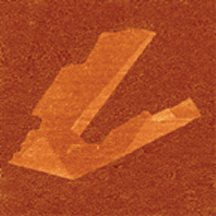Anyone who has written with a pencil may have unwittingly made a few traces of a promising new nanomaterial. Among the thick smears of graphite deposited when a pencil rubs along paper are probably some carbon films only a few atoms thick, says physicist Andre K. Geim of the University of Manchester in England.


In laboratory experiments, he and his colleagues at Manchester and in Russia have now created freestanding carbon films as thin as one atom. The researchers call the surprising material “few-layer graphene.”
In the Oct. 22 Science, the team also reports that it formed the material into a novel prototype transistor that’s expected to produce less heat than a conventional transistor does.
“I find this one of the most interesting discoveries that has emerged in condensed-matter physics in the last decade,” comments Laurence Eaves of the University of Nottingham in England.
These new findings are “truly outstanding” and “bear huge significance in this field” of carbon nanostructures, adds Philip Kim of Columbia University, who says he has made slightly thicker carbon layers with similar properties (http://xxx.arXiv.org/abs/cond-mat/0410314 and http://xxx.arXiv.org/abs/cond-mat/0410315).
The word graphene typically denotes the atom-thick carbon sheets that stack up to form graphite (SN: 4/19/03, p. 243: Available to subscribers at Between the Sheets: In reactors and nanotubes, errant atoms get a grip), the main ingredient of pencil lead. Researchers had suspected that short stacks of graphene layers would immediately curl into tubes, spheres, or other curved objects, Geim says.
The isolation of few-layer graphene, which is also known as graphene film, disproves that idea. It also adds an important new member—actually the progenitor—to a hotly pursued family of all-carbon nanomaterials. Scientists first stumbled upon the family in 1985 with the discovery of the soccer-ball-shaped sphere known as buckminsterfullerene, or buckyball. Buckyballs, carbon nanotubes (SN: 9/18/04, p. 180: Available to subscribers at Nanotech Goes to New Lengths: Scientists create ultralong carbon nanotubes), and other structures in the family can be envisioned as rolled up or otherwise reconfigured graphene sheets.
Besides being expected to show many of the technologically attractive traits of nanotubes, including steel-rivaling strength, graphene films can also cover a surface, Geim says. Therefore, their mechanical applications might include tough coatings and membranes for use in devices ranging from microphones to chemical sensors.
In one approach to making graphene films, Geim’s and Kim’s groups essentially rubbed tiny pieces of graphite against a hard silicon dioxide surface to detach flakes of the carbon material. In contrast, a team led by Walt A. de Heer of the Georgia Institute of Technology in Atlanta produced graphene via a different strategy. The Georgia group heated the surface of a wafer of silicon carbide so that the silicon atoms evaporated, leaving behind a few layers of carbon atoms that assembled into graphene. This approach yielded wafers entirely coated with the new material.
Given existing methods for making microcircuits, de Heer expects coated wafers to be more useful than graphene flakes. A report on his method is slated to appear in an upcoming Journal of Physical Chemistry.






